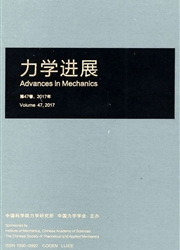

 中文摘要:
中文摘要:
我国航天工业迫切需要掌握可入轨后展开的大型网架式空间结构技术,以便研制口径十几米、乃至数十米的星载天线.该技术的主要科学基础是这类空间结构展开和服役过程的非线性动力学建模、分析和控制.本文综述了与上述科学基础相关的研究进展,提出应重点关注的3个科学问题:一是大型网架式空间结构展开过程的多柔体系统动力学,尤其是如何对微重力环境下索网的接触和缠绕、运动副内碰撞、结构展开与航天器本体间的耦合等导致的非线性动力学进行建模和分析;二是大型网架式空间结构展开锁定后服役的动力学分析,尤其是如何揭示结构柔性、众多运动副间隙、交变热载荷等因素引起的复杂非线性振动机理;三是大型网架式空间结构展开锁定后服役的动力学控制,尤其是如何在欠驱动、低能耗条件下对非线性振动和波动传播提出有效的控制方法.
 英文摘要:
英文摘要:
The space industry in China is eager to have the advanced technology of large space structures composed of trusses cables and meshes. Such a large space structure, deployed on orbit, may serve as the large antenna for different space missions. The important scientific basis of the technology is the nonlinear dynamics modeling, analysis and control of these space structures during their deployment and service. This review article surveys the advances in relevant researches and proposes three open problems as follows. The first is the flexible multibody dynamics for the deployment of such a space structure, especially the nonlinear dynamics modeling and analysis for the contacts and wraps of mesh under mi- crogravity, the internal impacts in clearance joints, and the coupling between structure deployment and spacecraft attitude. The second is the dynamics analysis of the space structures after deployment and during service, especially the complicated nonlinear vibrations of the flexible structure with numerous backlash joints under periodic thermal impacts. The third is the dynamic control of the space struc- tures after deployment and during service, especially the under-actuated and lower-powered control for structure vibrations and waves.
 同期刊论文项目
同期刊论文项目
 同项目期刊论文
同项目期刊论文
 期刊信息
期刊信息
